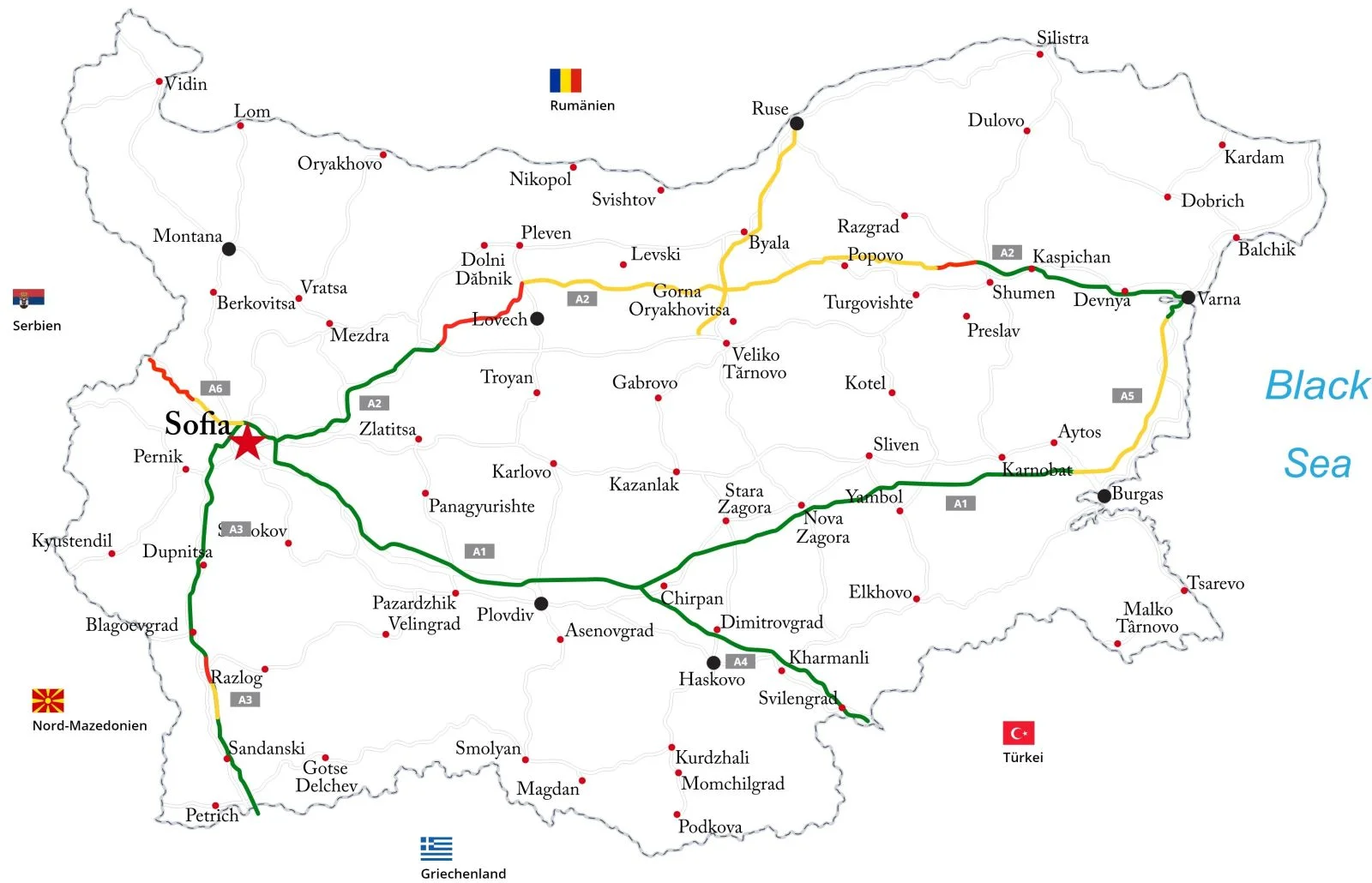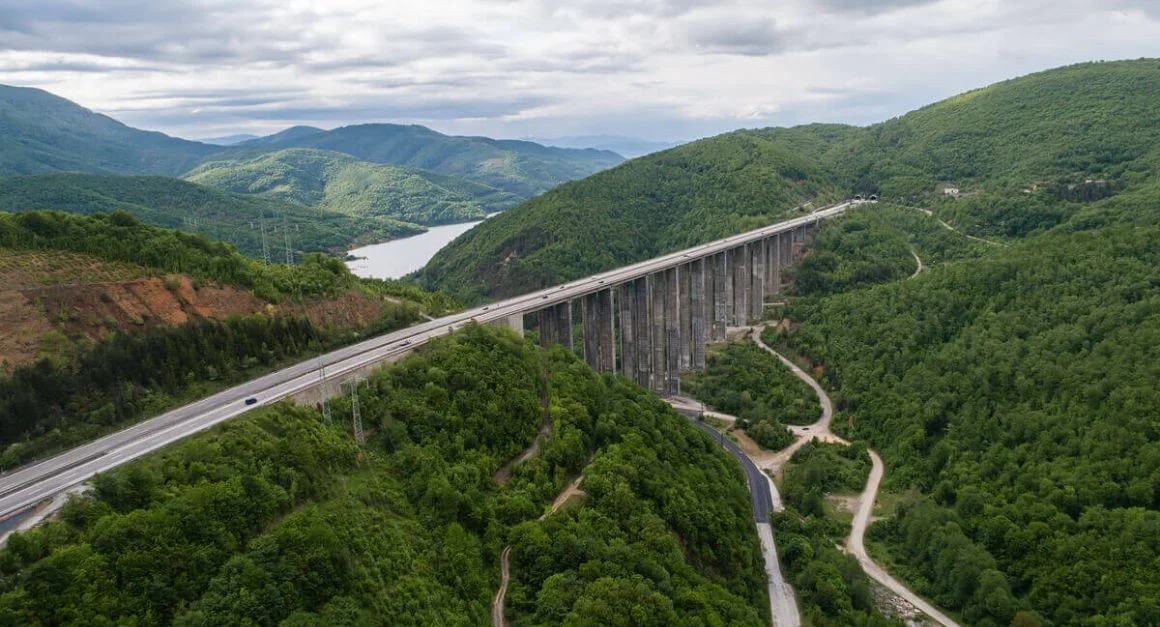Motorways in Bulgaria - Overview of Motorways
Many motorists end up on Bulgarian motorways sooner or later during their trip. For most of them, this happens right after crossing the border. Since special regulations apply to the country's motorways, just like in other EU countries, we will go into more detail about the motorway system in Bulgaria.
The Bulgarian motorways consist of a total of seven routes. This is significantly less than in other countries, but they are particularly important as connecting roads. They allow travellers to drive not only within Bulgaria but also to neighbouring countries. Some motorways in Bulgaria lead to the Greek, Turkish, Serbian, or Romanian border.
In the following article, we will go into more detail about the tolls and present all the information about the route.

The toll on motorways in Bulgaria
The official traffic rules in Bulgaria state that a vignette is required on all national motorways. Almost all vehicles (cars, campers, rental cars, etc.) are affected by this rule.
Bypassing the roads is out of the question for most drivers. Bulgaria does have a well-developed road network, but especially in the rural areas, the road quality worsens.
Instead of taking a (bumpy) detour, it is therefore a good idea to buy a vignette to use the motorways. There are several options to choose from. In Bulgaria, weekly, monthly, 3-month, and yearly vignettes are available.
The old vignette for the windshield is not available anymore. Instead, motorists must purchase an e-vignette in digital form. Vacationers who want to buy a vignette for Bulgaria can find suitable offers online. The toll fees can be paid via various methods of payment (e.g. Paypal, credit card etc.).
Motorway in Bulgaria: Map
The following map shows that the motorway network in Bulgaria covers large parts of the country. This confirms what we mentioned previously. The roads not only allow motorists to get from one place to another, but also to the country’s borders, and then continue to other countries such as Greece or Turkey. The following map shows an overview of the motorway sections.

Motorways

List of motorways in Bulgaria
The motorway network in Bulgaria is divided into seven sections. We will present each section of the motorway and explain where the connections start and where they lead.
A1
Many motorways in Bulgaria start in Sofia. This is also true for the A1, one of the longest and most important motorways in Bulgaria. It stretches over a length of 360 kilometres and runs across the country.
The motorway is also called "Awtomagistrala Trakija" and leads all the way to Burgas, a city on the Black Sea. Towards the eastern part of the country, it passes Plovdiv, Bulgaria's second-largest city.
A2
The A2, also called "Hemus", starts in the country's capital as well. Compared to the A1, however, it does not run south, but further north. Once the A2 is completed, it will be the longest motorway in Bulgaria reaching a total length of 427 kilometres, of which only 166 kilometres are in operation so far.
It runs via the city of Veliko Tarnovo to Varna, a port city on the Black Sea. People going on vacation by car often use the A2 to reach their destination.
A3
The A3 also begins in Sofia but takes a completely different route from the capital. This motorway continues to the southwest of the country and ends in the village of Kulata and thus at the Greek border. This is an important connection for vacationers travelling to Greece via Bulgaria.
A4
The A4 meets the A1 in the Upper Thracian Plain. It runs from Chirpan through towns such as Charmanli and Svilengrad to the border crossing at Kapitan Andreewo-Kapıkule. The route is often used by vacationers travelling to Turkey in their vehicles.
A5
The A5 motorway is also called "Awtomagistrala Cherno More". This term explains its course. The motorway is in the east of Bulgaria and is only partially completed so far. As soon as construction is completed, it will connect the two cities of Varna and Burgas. Perfect for travellers planning to spend their vacation on the Black Sea.
A6
In the future, the A6 will be used by travellers not planning on staying in Bulgaria, but only using the country for transit to Serbia. A length of 63 kilometres is planned, but so far only about half of it is in operation. This motorway in Bulgaria leads from the capital Sofia to the Serbian border.
A7
It is currently still unclear what will happen to the planned A7. In 2008, it was announced that this motorway would connect the A1, A2, and A3 in south-western Bulgaria. However, the actual construction of the freeway is still pending.

The future motorway network of Bulgaria
Based on the routes described above, you can see that many motorway sections on which the vignette for Bulgaria BGTOLL will be due are still under construction or in the planning stage. Bulgaria currently has a road network of 830 kilometres. Future motorway construction is expected to expand the network to over 1400 kilometres.
Speeds on the motorway
The speed limit for car drivers on the motorway in Bulgaria is 130 km/h. In some cases, the limit is raised to 140 km/h. Therefore, it is important to always pay attention to the appropriate speed signs. For truck and motorcycle drivers, the speed limit is 100 km/h.
Penalties must be expected for violations of the specified speeds. The amount of the fines is specified in the catalogue of fines. Anyone driving more than 50 km/h too fast must expect costs of more than 300 euros.